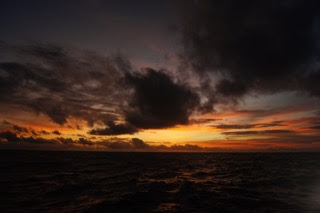Hi everyone,
We had a great passage from St Helena to Rodney Bay in St Lucia. It was a long passage of three phases - SE trades, ITCZ and NE trades.
First the usual plots:
Zen Again track
Zen Again Speed Over Ground
The track shows how we gybed in the SE trades. The speed plot shows two distinct strategies while we were in the SE trades. Initially we sailed "high" on the wind at higher boat speeds. Then we sailed "lower" and at lower speed but had better DMG (distance made good along our route). When speed builds again but with a lot of variation we are in the ITCZ. Then when speed stabilises and gradually increases we are in the NE trades.
Here are the vital stats for the passage…
- Distances/Speeds
- Route Distance = 3800nm
- Logged Distance = 4090nm
- GPS Distance = 4221nm
- Duration = 31 days 10 hours
- Average speed = 5.4kt
- Average VMG = 5.0kt
- Average day's run = 130nm
- Best day's run = 151nm (6.3kt)
- Minimum boat speed = 3 kt
- Maximum boat speed = 8 kt
- Weather
- Minimum wind speed = 4 kt
- Average wind speed = 16 knots
- Maximum wind speed = ~30kt (in squalls)
- Apparent wind angle range = 60 to 150
- Seas up to 2m
- Swell up to 2.5m
- Often cloudy but some gloriously sunny days and starlit nights
- Engine
- Total = 40 hours
- Driving = 16 hours (in ITCZ)
- Charging = 24 hours (mainly to ensure good power for our HF net control work)
- Consumption
- Water = 200 litres (6.5 litres / day)
- Fuel = 60 litres
- Failures
- Stars
- The boat!
- Extreme Sails mainsail and yankee
- Aries vane gear (steered 75% of passage)
- Icom HF/SSB radio
- Frigoboat fridge
- Sodastream water carbonator
- St Helena potatoes (lasted all the way)
- Satphone.Me email system (over Iridium GO!)
- PredictWind Offshore app (over Iridium GO!) for obtaining GRIBs
- qtVlm GRIB viewer and weather-routing software
- SeaIQ iPad navigation software
Current played a major part in the ITCZ and NE trades phases of the passage. We found the RTOFS GRIB data very helpful. Current assistance saved us at least a day at sea. Staying out of adverse current kept us out of very messy sea states. It is my belief the current flows are often narrower than shown by RTOFS, possibly with eddies around them which are not resolvable by RTOFS. This would explain the rapidly changing sea states we encountered from time to time. Along the north coast of Brazil we found best current a few miles off the continental shelf. One boat found very strong (4 knot) currents inshore as she approached a Brazilian port.
The SE trades were gentle, rarely rising above 18 knots. However they blew straight down the course so we did a lot of extra miles zig-zagging. Despite that it was mostly champagne sailing - very pleasant. Although there was swell it was quite long and the ride was mostly quite comfortable. Rain squalls were brief and with only slight increases in wind speed ahead of them.
We spent 3-4 days transiting the ITCZ. It appeared to jump around a lot while we were passing through, at least according to the Met Area V text forecasts. We saw no more than 25 knots of wind in the ITCZ so were very lucky. We did see lots of sheet lightning and were becalmed under several storm systems from which we escaped by motoring for several hours each time.
The NE trades were stronger than the SE trades and the swell shorter. The wind was generally a little aft of the beam. The swell was initially from the N and later from the NE. The N swell created a cross sea which made the ride less than comfortable. The swell originated from the North Atlantic (Azores) high pressure system which was very strong at the time. Staying in positive current was important here.
Commercial traffic was very intermittent during the passage, clearly running in shipping lanes which we went in and out of. Most coming close seemed to change course well in advance so we rarely felt the need to call them. Needless to say AIS was of great assistance, and our transmitter clearly encouraged ships to change course earlier than they would otherwise have done.
We were the HF/SSB net controller throughout the passage, recording over 300 positions. Our radio performed well. We also used DSC routine calling to poll the positions of some boats.
We used 200 of the 280 litres of fresh water aboard, an average of 6.5 litres per day (or 3.25 litres per person). We drank as much as we wanted without rationing. We drank a _lot_ in the ITCZ where the heat was oppresive. We did ration water for washing, each "earning" 0.5 litres/day which we used every other day or so.
We ate very well during the passage. Nic baked fresh bread every few days and even baked a cake when those prepared before departure were consumed. The St Helena potatoes lasted all the way (we ate some with lunch today). Nic is planning to post on her catering for the trip in a day or two.
Overall it was a great passage and a fantastic experience. It will take us a few days and a few rum punches for it to sink in that we are really in the Caribbean. Very cool.
































